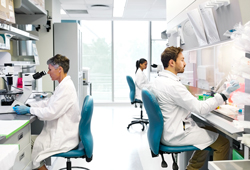 On Wednesday, January 15, 2020, during the J.P. Morgan Healthcare conference, Goodwin and KPMG held their initial all-day Symposium at the St. Regis hotel in San Francisco. The Symposium was composed of five separate “bursts” entitled (i) New Frontiers in Digital Diagnostics and MedTech, (ii) Europe Unleashed, (iii) Knowing the Best IPO Strategy, (iv) Trends in Biopharma and (v) Mergers and Acquisitions. Stéphane Bancel, the Chief Executive Officer of Moderna Therapeutics, provided the keynote address.
On Wednesday, January 15, 2020, during the J.P. Morgan Healthcare conference, Goodwin and KPMG held their initial all-day Symposium at the St. Regis hotel in San Francisco. The Symposium was composed of five separate “bursts” entitled (i) New Frontiers in Digital Diagnostics and MedTech, (ii) Europe Unleashed, (iii) Knowing the Best IPO Strategy, (iv) Trends in Biopharma and (v) Mergers and Acquisitions. Stéphane Bancel, the Chief Executive Officer of Moderna Therapeutics, provided the keynote address.
Burst Three consisted of four parts. In the first part, Amit Sinha from Goldman Sachs provided a summary overview of the U.S. IPO market for biotech in 2019 and provided thoughts on the U.S. IPO market for 2020. Amit noted that biotech issuances remained near record levels in 2019, and while 2019 IPO volume was down in comparison to 2018, company valuations remained higher. In addition, pricing of biotech IPOs in 2019 remained mixed. Numerous macro factors, such as the 2020 presidential election and continuing effect of executed tariffs, are expected to drive macro sentiment in 2020, but the overall sentiment is that the pace of IPOs will continue in 2020, with many companies seeking to go public in the first half of 2020.
The second part of Burst Three was a panel entitled “Traditional U.S. IPO Route: The Two Minute Drill to Complete a Successful IPO in the First Six Months of the Year.” This panel was moderated by Janet Lehman from KPMG and consisted of Tom Koncsics from KPMG, Michael Bison from Goodwin, Jack Cassel from Nasdaq and Amit Sinha from Goldman Sachs. In this panel, participants provided their advice regarding things for companies to consider if they want to go public in the near term.
The third part of Burst Three was a panel entitled “Hong Kong IPO: Seizing Opportunities in a New Emerging Market for Biotech IPO.” This panel was moderated by Wendy Pan from Goodwin and consisted of Irene Chu from KPMG, Michael Chan from the Hong Kong Exchanges and Clearing Limited (HKEX) and Bin Li from Lake Bleu Capital. In this panel, participants provided an update on the Hong Kong IPO market and provided advice for biotech companies seeking to list on the Hong Kong Exchange. Participants noted that since their new listing regime launched in 2018, 15 biotech companies listed on the main board by 2019, raising HK$48.6 billion in total, and amongst these, eight were pre-revenue biotech firms. The Hong Kong Exchange hopes to continue to expand the types of listed biotech companies in the future.
The final part of Burst Three was a panel entitled “Alternatives to U.S. IPO: Reverse Mergers and Direct Listings.” This panel was moderated by Deepa Rich from Goodwin and consisted of Gerry Schemidt from KPMG, Mitchell H. Gold from Alpine Immune Sciences and David Snyder from Exicure. In this panel, participants provided their insight regarding going public through the reverse merger process. Overall panelists had the sentiment that we are likely to see more reverse mergers in the future given the number of public companies that have gone public through the traditional route.
Key takeaways from Burst Three were as follows:
- Regardless of the strategy chosen for reaching the public markets, companies need to engage in various preparatory actions to ensure they are properly prepared, and therefore companies should engage with appropriate experts (legal, financial and stock exchange) early on in the process. Panelists stressed the importance of companies engaging experts, including legal and financial as early in the process of going public as possible in order to help them prepare for an efficient process. For example, in the traditional IPO process, legal experts can help the company understand timing for the various items that need to come together before a company goes public, while financial experts can help prepare the necessary audited financial statements for the registration statement. In a reverse merger process, engaging bankers early in the process can be useful in helping the company put together an attractive merger proposal. In all cases, the securities exchanges themselves can be helpful in providing the prospective public companies with resources to help the companies navigate the markets and listing compliance.
- Feedback with respect to the new biotech chapter of the Hong Kong Exchange has been positive, but companies need to understand that some challenges remain. Panelists noted that although the feedback on the new biotech chapter has been overwhelming positive, challenges to listing on the Hong Kong Exchange still remain. Panelists noted that certain aspects of the ecosystem need to grow further. For example, more bankers and investors that are knowledgeable in biotech are still needed. In addition, there is a need to better inform potential companies seeking to list on the Exchange of the differing disclose standards as compared to the disclosure standards in the United States.
- A reverse merger into an existing public company or a public company shell might be the best path to the public market for some companies, but the reverse merger process is unlikely to be cheaper than the traditional IPO route and is unlikely to be a true liquidity event. Panelists noted that a reverse merger may be the best path into the public market for some companies, for example, for companies whose capital structures do not allow them to go down the traditional IPO path, or for companies who are presented with an attractive proposal to merge into a failed existing public company. Panelists were also quick to note, however, that reverse mergers should not be viewed as a true liquidity event, because following or in connection with the reverse merger, a company needs to run a financing process. Therefore, panelists stressed that the reverse merger should be viewed as the beginning of the long process on the road to success.
 What financial arrangements between clinical trial sponsors and clinical investigators must be disclosed in a drug, biologic or device marketing application?
What financial arrangements between clinical trial sponsors and clinical investigators must be disclosed in a drug, biologic or device marketing application? Over the past year, the cost of obtaining D&O insurance for new public companies has increased substantially. Rates have increased from $50-60,000 per million dollars of coverage to over $150,000 per million dollars of coverage. Along with increased premiums, retention amounts have increased substantially (from $5 million to $10 million for smaller public companies up to $30 million for very large public companies). The increased cost of D&O insurance has been driven by the record level of securities class action filings over the last three years, as well as the increased settlement value of such actions (44% higher average settlement value in 2018 than the average of the past nine years according to Cornerstone Research). Further contributing to the increased cost is the U.S. Supreme Court’s ruling in the 2018 case, Cyan, Inc. v. Beaver County Employees Retirement Fund, that state courts can hear securities claims under the Securities Act of 1933, creating additional uncertainty regarding the outcomes of such cases. These factors in turn have caused some carriers to limit (or entirely eliminate) underwriting D&O insurance for new public companies.
Over the past year, the cost of obtaining D&O insurance for new public companies has increased substantially. Rates have increased from $50-60,000 per million dollars of coverage to over $150,000 per million dollars of coverage. Along with increased premiums, retention amounts have increased substantially (from $5 million to $10 million for smaller public companies up to $30 million for very large public companies). The increased cost of D&O insurance has been driven by the record level of securities class action filings over the last three years, as well as the increased settlement value of such actions (44% higher average settlement value in 2018 than the average of the past nine years according to Cornerstone Research). Further contributing to the increased cost is the U.S. Supreme Court’s ruling in the 2018 case, Cyan, Inc. v. Beaver County Employees Retirement Fund, that state courts can hear securities claims under the Securities Act of 1933, creating additional uncertainty regarding the outcomes of such cases. These factors in turn have caused some carriers to limit (or entirely eliminate) underwriting D&O insurance for new public companies. Yes. Many life sciences and biotech clients work with consultants that are associated with academic or research institutions. However, in considering whether to engage such a consultant, life sciences companies should be aware that the consultant will be subject to the intellectual property and conflict of interest policies of the associated institution. Most (if not all) academic or research institutions require their employees to assign ownership to the institution of any intellectual property (whether patentable or not) created by the employee either (1) in furtherance of the employee’s responsibilities for the institution or (2) using university resources (e.g., labspace, funding, laptops, etc.).
Yes. Many life sciences and biotech clients work with consultants that are associated with academic or research institutions. However, in considering whether to engage such a consultant, life sciences companies should be aware that the consultant will be subject to the intellectual property and conflict of interest policies of the associated institution. Most (if not all) academic or research institutions require their employees to assign ownership to the institution of any intellectual property (whether patentable or not) created by the employee either (1) in furtherance of the employee’s responsibilities for the institution or (2) using university resources (e.g., labspace, funding, laptops, etc.).